Adwords Ad Variations This Value Is Too Long Shorten It and Try Again
Is "Buy at present" a more than effective call to action than "Don't miss the boat"? Practice your prospects prefer to noodle around in a "costless trial" or would they rather "try [our] software"? What happens if yous invert your headlines? Do URL paths even thing, bro?!?!
When it comes to writing ads, these are the questions that haunt paid search aficionados. They're the crux of advertisement-centric A/B testing, and they've been notoriously difficult to answer for a whole gang of reasons, from a lack of time to sub-optimal advertizing rotation settings so some.
Until now.
Today, I'm going to run y'all through the nuances of Google'due south Ad Variations, a characteristic the search titan rolled out at the end of 2017 to assist advertisers examination fresh copy at scale. But offset…
The Case for Using Google Ads Variations
Be honest: When was the last time you implemented an A/B test in just one ad grouping? What near across your whole account?
I'd wager for well-nigh of united states of america, the answer is somewhere between staring shamefully into the spaces between F and Thousand on our keyboards and coming upward with some flippant, defensive quip. That's because generating fresh advert re-create takes time and thought.
Maybe there's a quarterly review in your three-month program, but it'due south probably not something you're doing every week. Testing ad copy tends to fall past the wayside because bid adjustments and negative keywords—fifty-fifty new buildouts—are much easier to generate quickly.
That being said, there'south a ton of untapped value in split-testing your advert creative. Figuring out what ad version incites more clicks (improves CTR) will amend your Quality Scores, which lowers CPCs, which ways you can run Fifty-fifty More ADS. This perpetual testing of ad copy helps you uncover more than constructive language to leverage on your landing pages, which can pb to more conversions. In short, testing your Google Ads (formerly known as Google AdWords) ads pays dividends!
I totally go that coming up with new copy—even a new headline—is tough; at calibration, it can feel similar a Sisyphean chore. Ad Variations are Google's attempt at making information technology a damn sight easier.
A cursory bated on why Advertisement Variations make me kinda sad or whatever
When I came to WordStream many moons ago as a Marketing Services rep, information technology was partly considering I couldn't get a chore as a copywriter. While I'd written a affair or two well-nigh a thing or two, I didn't have a polished portfolio. The ceaseless horde of cover messages I sent to every agency in Boston that explained exactly how and why I would slay all work that came my way went unanswered. Alas, I'd never realize my truthful potential: condign apex this guy, complete with MacBook…
I was crushed. But information technology worked out for the best.
I say that to say this: the beginning affair that excited me about Google Ads was, you lot know, writing ads (I know I'chiliad in the minority here). The Advertisement Variations feature, though a lovely innovation, does strip a few shreds of inventiveness from the advertisement writing process in favor of sheer efficiency.
While many volition rejoice, I'g pouring some out for the hours spent poring over customer websites and swollen spreadsheets coming upwardly with that perfect turn of phrase for every ad group.
And now dorsum to our scheduled programming.
Setting Advert Variations Up in Your Google Ads Account
To set up up Advertizing Variations in your business relationship, yous're going to demand to ensure that you're using the New Google Ads UI; to drive adoption, some of the new features Google has rolled out of belatedly are missing from the clunky former UI we all know and love.
On the page menu (the light gray bar to the right of your campaigns and ad groups), ringlet to the very bottom and select "Drafts and Experiments."
At the top of the D&Eastward page, leap correct over "Campaign Drafts" and "Campaign Experiments" and select yup, you guessed it, "Advertisement Variations." From here you can either click the large bluish circle or "New Advertizing Variations" to get started. Multiple methods. Variations, if you will. How meta!
Hither, y'all're going to demand to select the campaign in which you lot'd like to run advert variations. While you can cull to create variations for all campaigns simultaneously, to afford yourself some modicum of control over your messaging, you're better off implementing a new experiment for each campaign (or group of campaigns, depending on how your account is structured). It's also worth noting that, per Google, you can only create a single variation inside whatsoever given campaign over a given date range.
This means you can't run a dozen overlapping experiments. I can already hear the chorus of boo-hoos and "yes buts." Can it, I implore you lot. This isn't a bad thing: yous'd lose the advantage of achieving statistical significance efficiently if impressions are spread across besides many ads. While the power to iterate rapidly is fantastic, yous don't desire to bandage all-time practices asunder to do and so!
Anyway, now we come to the fun part: filtering.
Google offers you a whole mess of means to filter the ad copy in your campaign, ensuring that you only implement tests exactly where you want them. The first ad variation filter allows you to select ads based on constituent components, including:
- Headline (1, 2, both)
- Description
- Headline and Clarification
- Path (1, ii, both)
The second acts equally a modifier, allowing yous to select or exclude specific ads based on whether they contain, equal, start with, or end with a specific word or graphic symbol:
Improve still, is that fact that you lot can combine multiple filters, which allows you to come upwardly with something that looks similar this:
Of course, if you lot're simply looking to replace a common call to action or implement a new URL path, there's no need to go wild with the filter options. If you're looking to avoid wholesale change in favor of nuance, they'll quickly go your best friend. Gotta love that control.
And now, the fun role: actually creating your ad variations.
Google provides three split up types of ad variation you can create:
- Find and replace
- Update text
- Swap headlines
Let'south take a closer expect at each selection.
Detect and Replace
Kickoff up, we've got the "Find and Replace" ad variation. As the name so subtly suggests, this option allows y'all to find a word or phrase in some component of your text ads and swap it out with another.
This is the perfect selection if you'd like to test something similar "Purchase at present" vs. "Purchase today," or, if you lot're an artisan syrup-maker from the Light-green Mountain state, yous'd similar to change instances where y'all braggadociosly reference existence the all-time in "Vermont" to "The Earth." Dream large, people.
"Find and Supersede" allows you to adjust any component of your ads and gives you lot the selection to match instance (important to notation if your existing ads are written in title case vs. sentence example).
Update Text
The "Update Text" ad variant is more of a wholesale change than "Find and Replace," but it'south still reliant on your filters to have upshot. Let'due south say you want to swap out every Headline in a given campaign but would rather leave the Description and Paths intact, like then:
In this example, I've updated both headlines for ads in a competitor campaign (where including other brand names is incommunicable) for my exceptional, barrel-aged pure maple syrup. The get-go headline is an attempt at getting a laugh and, subsequently, a click; the second introduces my product to someone searching for a much larger competitor.
Is this something you want to roll out everywhere, all the fourth dimension? Probably not. But if information technology works in testing, it can be implemented beyond the board afterward achieving statistical significance. Don't permit fear stand in the way of a good thought!
(Of course, you can use "Update Text" variants to test less light-headed ideas, as well; if your ads tend to follow a formula, utilise that structure to supplant the components that don't include target keywords. This will allow you lot to get creative without sacrificing Quality Score).
Swap Headlines
And finally, we come to the lazy human special. "Swap Headlines" is pretty self-explanatory: information technology allows you to flip your Headline one and Headline 2 in the ads identified in your filter step.
If ever you've wondered how putting your CTA before your brand—or something comparable—would impact CTR, this is your chance to learn, en masse.
Go along in listen that you can likewise use Microsoft Ads IF functions to examination out the text in your Google ads.
Tracking and Applying Your Ad Variations
Once y'all've settled on a mode of ad variation, yous'll need to plant the details of your testing process.
Correct off the bat, you'll want to proper name your variant (in the case below I've cleverly named my variant "Name of Advertising Variant." Do yourself a favor: use a name that explicitly refers to your test, that way you know what you lot're looking at):
From there, you're going to need to assign a outset date and an end engagement for your variation. Kickoff with a timeframe of at least two weeks to give your ads time to accumulate some impressions. Simple plenty, right?
Finally, we come to the "Experiment Split" section. This is the final field before setting your new advert variation alive. Information technology refers to the percentage of your entrada upkeep that's "allocated to your variation and the per centum of auctions your variation is eligible to participate in." If you only want to bear an experiment with a small subset of your advert budget (which may exist the instance if you lot're testing something outlandish or are peculiarly budget-sensitive), suit your split up accordingly.
Once assigned, click "Create Variation" and kicking back (or, you know, become back to your normal routine optimization).
In terms of gauging the performance of your ad variation, the interface in which you created your experiment now doubles as a hub for analyzing its results. It allows y'all to see clicks, impressions, CTR, cost, and average CPC: more than enough information to decide whether or not your new copy's a keeper.
Finally, if y'all deem the results of your advertising variation successful enough to actually supplant your existing ads, click "Utilize"…
To bring up the "Use Variation" interface…
From here, you're given a total breakup of your ad variation (what kind of experiment you lot've been running how many ads were impacted) and iii potential courses of action:
- Interruption original ads and create new ads with this variation
- ***Remove original ads and create new ads with this variation*** [AVOID ME]
- Continue original ads and create new ads with this variation
Don't cull the second one. Ever. Your old ads are valuable: they have historic data! Don't delete them. Y'all can pause them and supervene upon them with your winning ad variation or run them simultaneously for a true carve up-test.
Then Now You Know How to Utilise Google Ads Variations: What Should You Exist Testing?
So, you've at present got the ability to exam anything, anywhere in your Google Ads account—at to the lowest degree where advertising copy is concerned: how do you avoid paralysis by analysis? Yep, knowing that you lot can implement impactful changes across every campaign with a bright idea and a few clicks tin be every bit frustrating as a facing down a hundred ad groups in need of fresh re-create (and a whole workday).
Luckily, I've pulled together a handful of ideas that you can employ to test your artistic using Ad Variations correct this instant (most of which were ripped direct from our own research on meridian-performing search ads).
You lot're welcome.
Get weird with your CTA
The CTA is a central component of your ad creative, just most people tend to attempt to pop it into their second headline and telephone call it a mean solar day. Why non employ Google Ads Variations to test CTA placement? You can attempt it before you address your target keyword, by putting it in the Headline ane, or put it in the description and utilize both headlines to focus on communicable the eyes of your prospects with colorful linguistic communication.
While you're at it, why not take a new verb for a spin? According to our research, "Buy" or "Store" or "Get" make for effective CTA verbs: pit them against ane another with a "Notice and Replace" variant and see which ane works all-time in the context of your account.
Leverage positivity (or, you know, don't)
Here'southward some other place where the "Find and Supersede" variation can come in clutch. Sentiment is an important—though often overlooked—slice of writing search ads. Our analysis of more than 600 ads revealed that 45% of top-performers use positive sentiment to bang-up effect.
That being said, for some advertisers, negative sentiment tin be a valuable tool. Causing a prospect to feel fearfulness or giggle with glee beats going unnoticed, and advertizement variations can assistance you figure out which tactic resonates with searchers in your vertical.
Features? Benefits? Why not both?
A lot of marketing comes down to features vs benefits. And when it comes to Google Ads, characteristic-dominant copy is everywhere. Why non apply Google's Ad Variations to test which approach does a better chore of communitcating your value prop?
Here's how that plays out with each version of Ad Variations:
- Find and replace: Replace a affair (feature) with what that thing helps your prospects accomplish (benefit).
- Update text: Swap out entire clarification lines to test whether benefits are worth focusing on in your ad copy (if you're nervous well-nigh dumping features, remember that you tin include them in your callout extensions and structured snippets).
- Swap headlines: Endeavour a feature-axial Headline 1 and a benefit-centric Headline two (where does the CTA go? You be the approximate); reverse, rinse, and repeat.
By testing "what does my product do" against "how does my production make your life better" in every campaign in your account—regardless of search intent—you lot tin can unlock the secrets to both CTR and CVR.
Final Thoughts
Thanks to the Google Ads Variations feature, it's never been easier to determine your top-performing ad artistic and and so exam (and test and test and test) some more. Merely, oddly plenty, in that location don't seem to exist too many advertisers taking advantage of it.
Practice you scent that? That, my friend, is opportunity.
Source: https://www.wordstream.com/blog/ws/2018/02/13/adwords-ad-variations
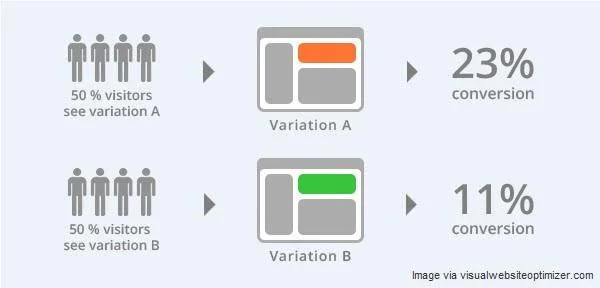


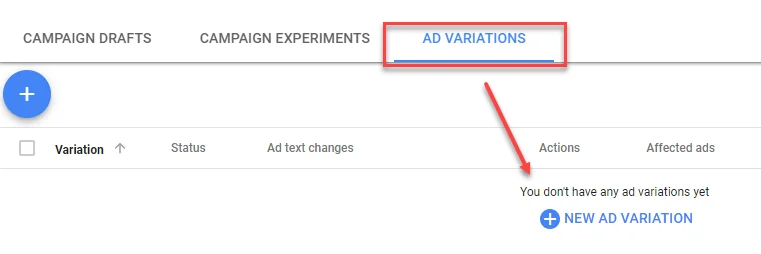


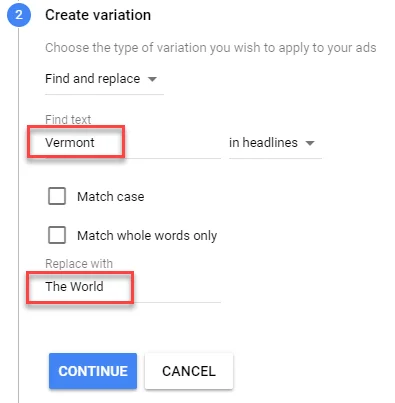
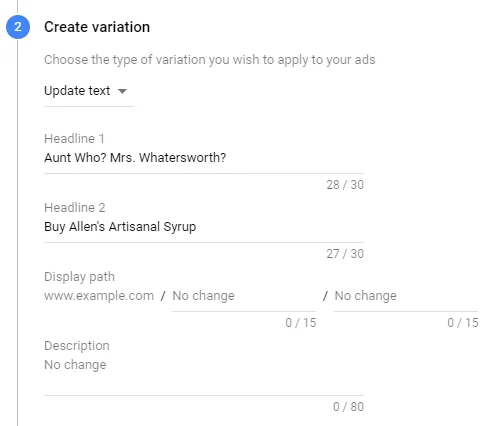
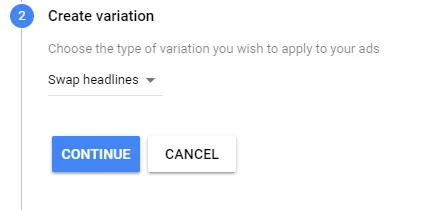
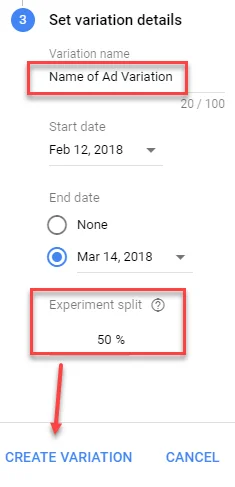

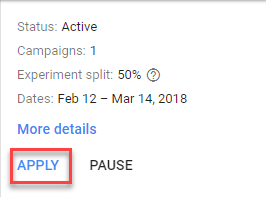
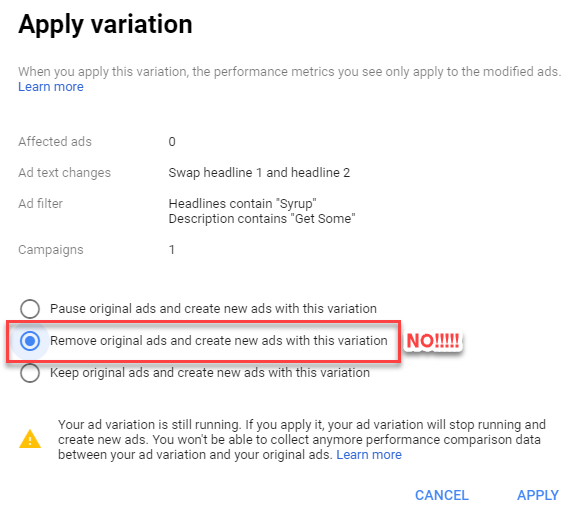


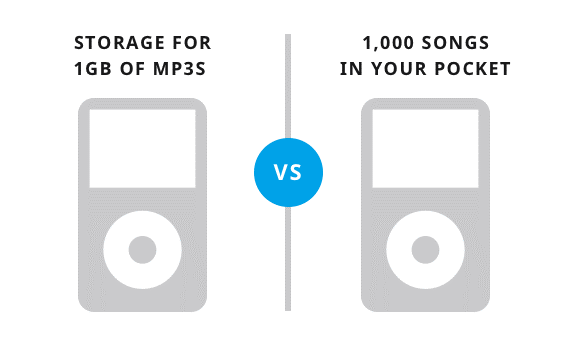
0 Response to "Adwords Ad Variations This Value Is Too Long Shorten It and Try Again"
Post a Comment